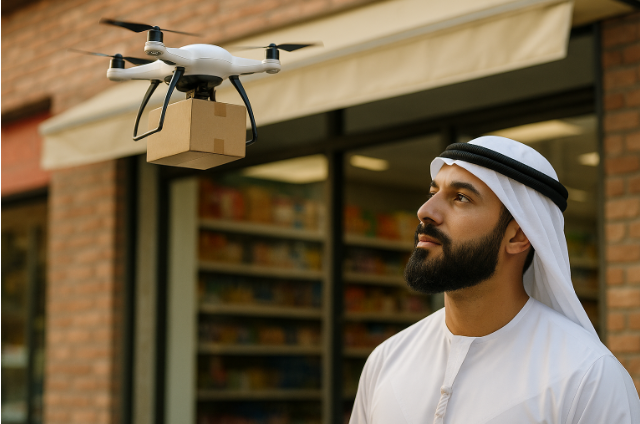How Delivery Drones Will Shape Retail Logistics
Logistics has always moved with the tools of its time. In the nineteenth century, camels and steamships carried goods across long distances. For many decades, the van and cargo plane ruled retail movement. Now, a new device joins that list – the autonomous drone.
Drones add vertical layers to ground-based transport. They fly direct paths, avoid traffic, and reduce last-mile delays. Their growing use mirrors how digital offers, such as https://om.1xbet.com/en/promo, integrate seamlessly into shopping habits. Both tools rely on fast response and targeted delivery. When demand spikes, speed becomes the deciding factor.
In retail, faster delivery builds customer trust. In betting, faster platform response secures engagement. Drones now support both by reshaping how physical goods meet digital demand.
Time compression and market response
Retail thrives when customers trust delivery promises. Drones reduce the distance between warehouse and doorstep. Urban tests show average delivery times of under 30 minutes. That time window opens new planning models in betting, especially for campaigns tied to product arrivals or event kits.
Small electronics, documents, and promo packs move faster in dense cities through drone routes. Each successful drop shortens inventory cycles. That affects marketing and betting campaigns linked to season launches or match days.
Immediate benefits of drone-based delivery:
- Less pressure on human couriers
- Fewer delays caused by road congestion
- New options for short-notice campaigns
- Greater control over high-demand days
- Better integration with flash sales and loyalty rewards
This tighter delivery loop creates momentum. Customers do not wait days. Retailers adjust stock forecasts weekly. Betting platforms launch offers in sync with merchandise trends.
Infrastructure and regulation progress
Not all regions allow drone deliveries yet. Airspace laws, safety rules, and infrastructure gaps still limit expansion. However, clear progress exists. Controlled drone corridors now exist in several urban pilot zones. Rooftop landing pads and automated lockers make receiving goods more precise.
In some Middle Eastern cities, partnerships with tech hubs accelerate drone regulation. These collaborations focus on heat-resistant designs, flight stability in wind, and local air rights. The results shape future patterns for wider industries. Betting content firms, for example, use the same drone logistics to send branded merchandise during tournaments.
Critical systems enabling drone retail growth:
- Real-time route planning software
- Weather-adaptive drone flight controls
- Portable landing surfaces for homes and small shops
- Data links between fulfilment software and flight API
- Localised air traffic conflict-avoidance systems
These systems turn drone fleets into commercial infrastructure. As they scale, more industries benefit – including those built on fast, time-linked digital interaction.
Automation beyond parcel delivery
The same drones used for packages also serve in surveillance, surveying, and event mapping. In betting, drones support image capture for live-event accuracy, especially in less accessible areas. They monitor crowds, verify conditions, and send timestamped updates.
This crossover shows how drone value lies not in transport alone but in timing. Knowing the exact arrival of a promotional item allows better push notifications and in-app campaign sync.
Drones bring visibility, speed, and confirmation. Their real strength is not speed in air, but precision on arrival.
Sector integration and future cycles
Drone adoption brings ripple effects. Retail sites redesign inventory zones to match drone size limits. Packaging shrinks to reduce flight weight. Data science teams now work alongside drone logistics engineers to analyse best-flight times and return loop frequency.
These changes reach platforms connected to betting. Operators use similar logic when timing deposit bonuses or cross-selling matchday packs. Shorter cycles require tighter coordination between marketing, fulfilment, and mobile alerts.
Some drone services now operate like data feeds. They do not just deliver items – they deliver proof of presence. That certainty becomes valuable when platforms need to verify delivery before triggering a loyalty reward.
Future betting-linked drone applications:
- Branded parcel drops before high-odds events
- Delivery verification for bonus unlocks
- Event ticket packages with weatherproof drone release
- Fast response merchandise for surprise results
- City-based mini-leagues supported by drone prize delivery
This blend of timing, trust, and technology marks a shift from traditional logistics. The drone is no longer a novelty. It is a planning tool for platforms that rely on rhythm.
A new layer in the delivery chain
The retail chain is not broken. It is layered. Drones cover the short legs that trucks cannot reach fast enough. That final kilometre, often the most expensive, becomes manageable.
Two centuries ago, traders watched for sails on the horizon to predict supply. Now, platforms monitor drone fleets to adjust inventory and user messaging. What once took days now completes in minutes. Betting, commerce, and content all benefit from this shift.
The future of delivery is not just fast. It is synchronised. Drones offer that coordination between digital demand and physical action. Retailers gain loyalty. Platforms gain speed. Users gain satisfaction from orders arriving exactly when expected – and sometimes, just before the next match begins.

Leave a Reply